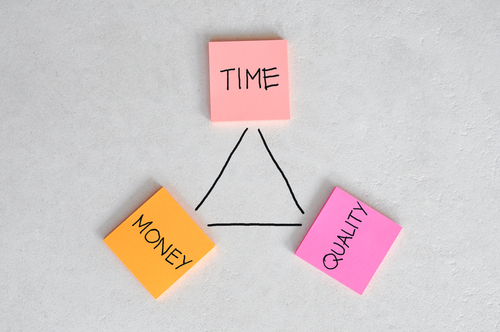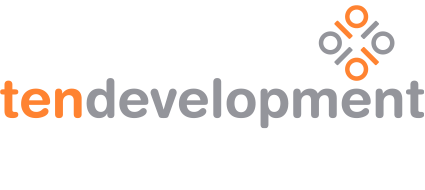
Time, Cost, Quality – You Can’t Have it All!
 Just the other day I was reminded of one of the best bits of advice I was ever given by Sam my manager from a few years back after being let down by a roast chicken of all things!
Just the other day I was reminded of one of the best bits of advice I was ever given by Sam my manager from a few years back after being let down by a roast chicken of all things!
As usual I went to our local Sainsbury to get all the things my daughter Rae and I needed for a lovely Sunday lunch. I normally buy free range but on this occasion when I got to the poultry isle there weren’t any free range birds left although they still had plenty of the cheaper chickens for sale. Almost without thinking about it I put one of the cheaper birds in the trolley. It was still a chicken right, how different could it be?
Well the honest answer to that is very! Yes the cheaper chicken looked delicious after it came out of the oven with crispy golden skin but to our dismay it was like eating cotton wool; it had absolutely no flavour at all. Needless to say Rae and I didn’t bother eating much of it and more than three quarters of the chicken went in the bin. I have always previously bought free range as I knew the quality was higher, even though they did usually cost that bit more and this experience reinforced my theory.
It is also what reminded me of the advice Sam had given me. Whilst we were working on a major project, Sam said to me that every key business decision you make will be defined by three things; TIME, COST and QUALITY. She explained to me how important it was to understand which of those three things would be my priority for each decision I would need to make. At first I challenged her on this, but she told me to visualise a triangle, with time as one point, quality as another and cost as the third and final point.
She explained that by pulling one point of the triangle to emphasise it and make it more prominent, it changes the shape of the triangle and subsequently impacts on the other two points. Yes you may start with an exact equilateral triangle, but in her experience one of those three points (time, cost, quality) will always become more important than the other two. When that happens, the decisions to be made need to bear in mind the impact on the other two elements. For example:
• If cost is the priority, the quality is likely to be less but time may be quicker
• If time is the priority, the quality is likely to be less but the cost is likely to increase
• If quality is the priority both the time and cost are likely to increase.
After my roast chicken experience it was easy to see quality was the most important thing for me. At the time had I realised this I would have got back in the car and driven to another supermarket to get one of their free range birds. Yes this would have had an impact on the time and there would have been some additional cost but I would have been happy with the result and we would have definitely eaten more. Actually Rae and I ended up wasting money, as most of the chicken went in the bin and we were still hungry!
There is no right or wrong answer, it’s just about been really clear about which one of the three is your biggest priority, and in our experience one will always be more important than the other two! This is happily one of the things that we’ve seen many of our clients considering more and more over the last couple of years.
In my previous life in a small training business before we set up tendevelopment, many of our clients would say things that made it really clear what their priority was, even if they didn’t recognise it as such. For example they would often insist on only one day courses to avoid their people being out of the business for too long, so clearly time was their priority. Or, they might say: ‘we have a really tight budget what could you do for us with this in mind?’ indicating a clear priority of cost. These challenges are completely understandable and by no means invalid. However what our clients back then failed to realise is the impact these priorities had on how good the learning outcomes were, how much knowledge the participants would retain and more importantly how much they would be able to actually implement back in the workplace to effect any sustainable change.
It would be marvellous if all our clients, even today, were able to say to us: ‘please come in and do a complete diagnostic, speak to the people to find out what our needs are and then design our subsequent programme around what you find.’ We have first-hand experience of doing exactly this and even today 10 years down the line the participants on that programme are still using the tools and techniques it contained. While this does happen sometimes, it is certainly not commonplace, as most organisations today are juggling a multitude of priorities, budgets, projects etc. and developing their people is one of these.
Of course we would want quality to be the number one priority every time, but on a more realistic level we now find ourselves advising clients to firstly identify and then focus on the most important things for them right now, which of the three, time, cost, quality is their biggest priority and with that in mind what would give them the biggest bang for their buck. For example if time is a priority only tackle one or two skills at a time, like helping leaders to hold great one to one conversations with their people or how to deliver difficult messages and look at self-directed learning methods; if cost is a priority do small bitesize chunks in house or develop your own internal resource to deliver the training.
The only caveat we would add is that just as we need to be realistic about quality not always been number one, organisations need to understand the impact of prioritising the other two ahead of it, as both are likely to reduce the effectiveness and sustainability of the learning.
Unfortunately there isn’t a perfect answer and sometimes it’s hard to make the choice. But please don’t follow my Sunday chicken example and throw the development you’ve paid for in the bin because it didn’t do for you what you wanted it to. As Sam explained to me all those years ago, it’s about making a conscious decision to prioritise which of the three is most important at any given time, your rational for doing that and then understand the impact it will have on the other two elements. That way you’ll be far more likely achieve the outcome you’re after.
If you have a time, cost, quality leadership dilemma you’d like to get some help with please don’t hesitate to get in touch. You know what they say… ‘a problem shared is a problem halved’
All the best
Martin


No Comments